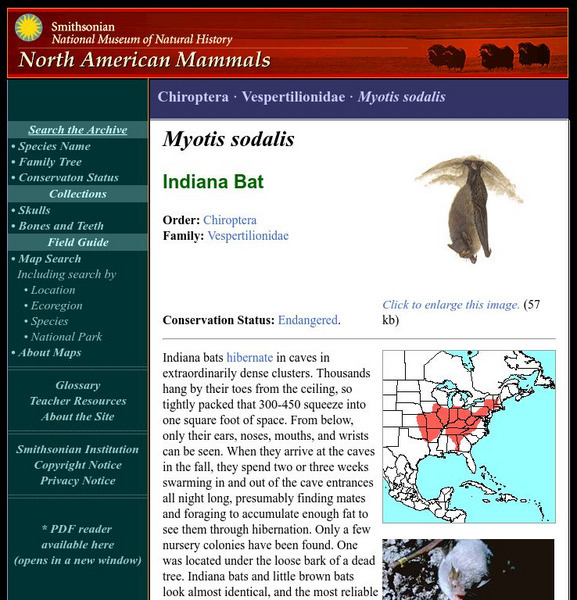Smithsonian Institution
National Museum of Natural History: American Mammals: Western Small Footed Myotis
The western small-footed myotis occurs in limited areas of southwestern Canada, throughout much of the western United States, and into Mexico. It is better adapted to moist areas than to dry ones. Learn more about the Myotis ciliolabrum,...
Smithsonian Institution
National Museum of Natural History: American Mammals: Southwestern Myotis
Southwestern myotis live in a variety of southwestern mountain habitats, from desert grasslands up into pine and mixed coniferous forest in the United States, and in desert and grassland in Mexico. These bats and two other myotis...
Smithsonian Institution
National Museum of Natural History: American Mammals: Northern Long Eared Myotis
Although the northern long-eared myotis is common and widespread, much remains to be learned about its roosting habits, reproduction, and longevity. This bat is known to hibernate in caves and mines and to roost under tree bark. Learn...
Smithsonian Institution
National Museum of Natural History: American Mammals: Indiana Bat
Indiana bats hibernate in caves in extraordinarily dense clusters. Thousands hang by their toes from the ceiling, so tightly packed that 300-450 squeeze into one square foot of space. Learn more about the Myotis sodalis, more commonly...
Smithsonian Institution
National Museum of Natural History: American Mammals: Keen's Myotis
Keen's myotis is a medium-sized bat with a long tail. It does not demonstrate narrowly specialized habitat needs. Learn more about the Myotis keenii, more commonly known as a Keen's Myotis, in this easy-to-read species overview by the...






